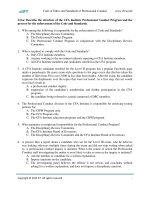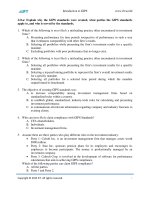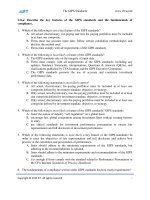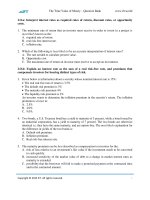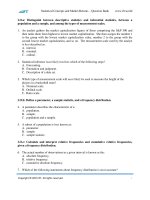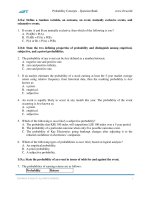CFA 2018 quest bank r46 security market indices q bank
Bạn đang xem bản rút gọn của tài liệu. Xem và tải ngay bản đầy đủ của tài liệu tại đây (250.06 KB, 12 trang )
Security Market Indices – Question Bank
www.ift.world
LO.a: Describe a security market index.
1. Analyst 1: A security market index represents the level of risk in the market.
Analyst 2: A security market index represents the security market, market segment or asset
class.
Which analyst‟s statement is most likely correct?
A. Analyst 1.
B. Analyst 2.
C. Neither.
2. Which of the following is least likely true with regards to security market indices?
A. Security market indices measure the value of different target markets.
B. Index values are calculated using estimated or actual values of constituent securities.
C. Once defined, the constituent securities are not changed.
LO.b: Calculate and interpret the value, price return, and total return of an index.
3. Index P is a price return index. Index T is a total return index. Both have a starting value of
1000. Both have the same underlying securities and weighting system. Six months after
inception the two index values will most likely be equal if:
A. the indices have not been rebalanced.
B. the indices have not been reconstituted.
C. the constituent securities do not pay dividends or interest.
4. An analyst gathers the following information for KSE3 index comprised of HBL, FFCL and
EFOODS. This is a price-weighted index.
Security
HBL
FFCL
EFOODS
Beginning of period price End of period price (Rs.)
(Rs.)
148
153
104
110
110
90
Total
(Rs.)
8
5
4
Dividend
The price return of the index is closest to:
A. -2.5%.
B. -2.9%.
C. -10.9%.
5. A market-capitalization-weighted index consists of securities ABC, DEF and GHI:
Security Beginning of Period
Price
ABC
1,500
DEF
2,500
GHI
500
End of Period
Price
1,700
1,500
600
Dividends per share Share Outstanding
10
15
10
6,000
8,500
10,000
The price return of the index is closest to:
A. -10.33%.
B. -17.87%.
Copyright © IFT. All rights reserved.
Page 1
Security Market Indices – Question Bank
www.ift.world
C. -13.90%.
6. Peter gathers the following information for a market-capitalization- weighted index
comprised of securities ABC, DEF and GHI.
Security Beginning of
period price
ABC
1,500
DEF
2,500
GHI
500
End of period
price
1,700
1,500
600
Dividends per share Shares outstanding
10
15
10
6,000
8,500
10,000
The total return of the index is closest to:
A. 1.04%.
B. -17.06%.
C. -10.23%.
7. An analyst gathers the following data for a price-weighted index:
Security
A
B
C
Beginning of period
Price $
Shares
10
100
40
150
16
200
End of period
Price $
15
38
20
Shares
100
150
200
The price return of the index over the period is closest to:
A. 10.61%.
B. 17.1%.
C. 21.4%.
8. John gathers the following data for a value-weighted index:
Security
A
B
C
Beginning of period
Price $
Shares
10
100
40
150
16
200
End of period
Price $ Shares
15
100
38
150
20
200
The return on the value-weighted index over the period is closest to:
A. 7.1%.
B. 9.8%.
C. 11.4%.
9. John gathers the following data for an equally-weighted index:
Beginning of period
Security Price $
Shares
A
10
100
B
40
150
C
16
200
Copyright © IFT. All rights reserved.
End of period
Price $ Shares
15
100
38
150
20
200
Page 2
Security Market Indices – Question Bank
www.ift.world
The return on the index over the period is closest to:
A. 25.2%.
B. 16.8%.
C. 23.3%.
10. Alex gathers the following information for an equal-weighted index comprised of assets A,
B, and C:
Security Beginning of period price $ End of period price $ Total Dividends $
A
20
15
2
B
40
48
4
C
60
60
9
What is the price return of the index?
A. 10.0%.
B. -1.7%.
C. -2.5%.
11. Alex gathers the following information for
B, and C:
Security Beginning of period price $
A
20
B
40
C
60
The total return of the index is closest to:
A. 5.0%.
B. 7.5%.
C. 10.0%.
an equal-weighted index comprised of assets A,
End of period price $
15
48
60
Total Dividend $
2
4
9
LO.c: Describe the choices and issues in index construction and management.
12. The second major question to address when constructing an index is most likely:
A. What is the target market?
B. When should the index be rebalanced?
C. Which securities should be selected from the target market?
13. Analyst 1: Objective or mechanical rules are used to determine the constituent securities of
most indices.
Analyst 2: Some indices use a selection committee and subjective decision making rules to
determine constituent securities.
Which analyst‟s statement is most likely correct?
A. Analyst 1.
B. Analyst 2.
C. Both.
LO.d: Compare the different weighting methods used in index construction.
Copyright © IFT. All rights reserved.
Page 3
Security Market Indices – Question Bank
www.ift.world
14. The index weighting method that requires adjustment to the divisor after a stock split is:
A. price weighting.
B. equal weighting.
C. float adjusted market-capitalization weighting.
15. Which of the index weighting methods leads to indices that have a value tilt?
A. Market-capitalization weighting.
B. Fundamental weighting.
C. Float-adjusted market-capitalization weighting.
16. The index weighting that has a momentum effect is most likely to be:
A. equal weighted.
B. fundamental weighted.
C. market-capitalization weighted.
17. Jim is looking for a method that is least likely to require rebalancing. Which one of the
following methods would Jim select?
A. price weighting.
B. equal weighting.
C. fundamental weighting.
18. Which of the following is least likely a characteristic of fundamental weighting of an index?
A. Index will have a contrarian effect.
B. Index will use multiple measures to weigh constituent securities.
C. Index will include all shares.
19. Which of the following type of market index most likely requires frequent rebalancing?
A. Equal weighted.
B. Market-capitalization weighted.
C. Price weighted.
20. Contrarian “effect” is most likely a characteristic of which of the following types of index
weighting methods?
A. Market capitalization weighting.
B. Price weighting.
C. Fundamental weighting.
21. High transaction costs reduce portfolio returns due to rebalancing. Which of the following
indices is most likely to experience this?
A. Equal weighted.
B. Price weighted.
C. Value weighted.
LO.e: Calculate and analyze the value and return of an index given its weighting method.
Copyright © IFT. All rights reserved.
Page 4
Security Market Indices – Question Bank
www.ift.world
22. The following information is available for an index:
Value of the index as of December 31, 2012: 1,000
Interest income over the year 2012: 45.50
Dividend income over the year 2012: 12.00
Total return of the index over the year 2012: -3.50%
The value of the index as of January 1, 2012 is closest to:
A. 1,073.
B. 1,084.
C. 1,096.
23. The index weighting method that most likely requires an adjustment to the divisor after a
stock split is:
A. fundamental weighting.
B. market-capitalization weighting.
C. price weighting.
24. The data for four stocks in a price-return index are as follows:
Stock
Shares
%
Beginning
End of
Dividends
Outstanding
Shares
of
Period
Per
in
Period
Price
Share ($)
Market
Price ($)
($)
Float
1
2000
80
25
28
1.5
2
5000
90
13
11
2.0
3
4000
60
44
42
2.5
4
6000
50
38
45
1.5
Assuming the beginning value of the float-adjusted market-capitalization-weighted equity
index is 100, the ending value is closest to:
A. 103.8.
B. 105.8.
C. 110.7.
LO.f: Describe rebalancing and reconstitution of an index.
25. Rebalancing is most likely to involve:
A. adding or removing securities to maintain consistency with the target market.
B. adjusting securities‟ weight to keep the turnover stable.
C. adjusting securities‟ weights to maintain consistency with the index‟s weighting
method.
26. What does reconstitution of a security market index help reduce?
A. Portfolio turnover.
B. Market-capitalization weighting of the index.
C. The likelihood that the index includes securities that are not representative of the
target market.
Copyright © IFT. All rights reserved.
Page 5
Security Market Indices – Question Bank
www.ift.world
LO.g: Describe uses of security market indices.
27. Which of the following is least likely true about security market indices?
A. Indices allow us to gauge market sentiment.
B. Indices serve as investment vehicles.
C. Indices serve as a basis for investment products.
28. Analyst 1: Security market indices serve as market proxies when measuring risk-adjusted
performance.
Analyst 2: Security market indices are often used as benchmarks to evaluate the performance
of active portfolio managers.
Which analyst‟s statement is most likely correct?
A. Analyst 1.
B. Analyst 2.
C. Both.
LO.h: Describe types of equity indices.
29. An index that contains securities with more than 90% of the market‟s total value is most
likely a:
A. broad market index.
B. sector index.
C. multi-market index.
30. An example of a style index is an:
A. index based on geographic regions.
B. index based on economic sector.
C. index based on value stocks.
LO.i: Describe types of fixed-income indices.
31. On the basis of market, fixed income indices can be least likely classified as:
A. global.
B. currency zone.
C. investment grade.
LO.j: Describe indices representing alternative investments.
32. Which of the following is least likely true with regards to hedge fund indices?
A. Returns are generally overstated.
B. Hedge funds can decide whether to report their performance to index creators.
C. Returns are generally understated.
33. What is most likely a feature of hedge fund indices? They:
A. are frequently equal weighted.
B. are determined by the constituents of index.
Copyright © IFT. All rights reserved.
Page 6
Security Market Indices – Question Bank
www.ift.world
C. reflect the value of private rather than public investments.
34. Which of the following statements regarding commodity indices is least likely correct?
A. Most commodity indices use the same weighting methods.
B. Commodity indices containing the same underlying commodities might have
different returns.
C. Most commodity indices are based on commodity futures contracts.
35. Which of the following is least likely to be an issue pertaining to a commodity index?
A. Commodity indexes are based on future prices, rather than spot prices.
B. Commodity indexes may vary due to the use of different methodologies of
determining weights.
C. Commodity indexes may show an upward bias due to the reflected performance of
only surviving commodities.
LO.k: Compare types of security market indices.
36. An index based on market capitalization most likely:
A. requires frequent rebalancing.
B. has a value tilt.
C. is influenced by overpriced securities.
37. An example of a style index is an index based on:
A. geographic regions.
B. economic sector.
C. value stocks.
38. Which of the following is least likely a real estate index category?
A. Repeat sales index.
B. Initial sales index.
C. Appraisal index.
39. Tim is working on his assignment to compare equity indices with fixed-income indices. From
his class lecture, he recalls that 1) fixed income securities are harder to replicate 2)
constituent securities of fixed-income indices are more liquid, and 3) constituent securities of
fixed income indices are drawn from a larger pool as compared to securities of equity
indices. Out of the three facts he recalls, which of the following is least likely correct?
A. Fixed income securities are harder to replicate.
B. Constituent securities of fixed-income indices are more liquid.
C. Constituent securities of fixed income indices drawn from a larger pool.
Copyright © IFT. All rights reserved.
Page 7
Security Market Indices – Question Bank
www.ift.world
Solutions
1. B is correct. A security market index represents the security market, market segment or asset
class.
2. C is correct. Most major indices are reconstituted periodically.
3. C is correct. Income generated over time by underlying securities in terms of dividend or
interest creates a difference between a price return index and a total return index consisting
of identical securities and weights. If the securities in the index do not generate income, both
indices will be identical in value.
4. A is correct. The price return of the price-weighted index is the percentage change in price of
the index:
–
= - 2.49%.
Security
HBL
FFCL
EFOODS
TOTAL
Beginning of period price
148
104
110
362
5. B is correct. The price return of the index is
End of period price
153
110
90
353
–
= -17.87%.
6. B is correct. The total return of the market-capitalization-weighted index is calculated below:
Security
Beginning of Period
Value
End of Period
Value
Total
Dividend
Total
Return %
ABC
DEF
GHI
Total
9,000,000
21,250,000
5,000,000
35,250,000
10,200,000
12,750,000
6,000,000
28,950,000
60,000
127,500
100,000
287,500
14
-39.4
22
-17.06
7. A is correct. The sum of prices at the beginning of the period is 66; the sum at the end of the
period is 73. Regardless of the divisor, the price return is
= 0.1061 or 10.61percent.
8. B is correct. It is the percentage change in the market value over the period:
Market value at beginning of period:
= 10,200
Market value at end of period:
= 11,200
Percentage change is
– = 0.09804 or 9.8 percent with rounding.
Copyright © IFT. All rights reserved.
Page 8
Security Market Indices – Question Bank
www.ift.world
9. C is correct. With an equal-weighted index, the same amount is invested in each security.
Assuming $500 is invested in each of the three stocks, the index value is $1,500 at the
beginning of the period and the following number of shares is purchased for each stock:
Security A: 50 shares.
Security B: 12.5 shares.
Security C: 31.25 shares.
Using the prices at the beginning of the period for each security, the index value at the end of
the period is $1,850:
. The price return is
= 23.3%.
10. B is correct.
The price return of the index equals the weighted average of price returns of the individual
securities.
Return of A: -25percent =
Return of B: 20 percent = [
];
–
Return of C: 0 percent = [
].
The price return index assigns equal weights to each asset; therefore, the price return is
[
] = -1.7%.
11. C is correct.
The total return of an index is the price appreciation, or change in the value of the price
return index, plus income (dividends and/or interest) over the period, expressed as a
percentage of the beginning value of the price return index.
Return of A:
Return of B:
–
–
= -15%
= 30%
–
Return of C:
= 15%
An equal-weighted index applies equal weight to each security‟s return; therefore, the total
return =
= 10%.
12. C is correct. The first major question to address is what is the target market? The second
major question is what securities to select from the target market?
13. C is correct. Both statements are correct.
14. A is correct. The index weighting method that requires an adjustment to the divisor after a
stock split is the price weighing method.
15. B is correct. Fundamental weighting leads to indices that have a value tilt.
Copyright © IFT. All rights reserved.
Page 9
Security Market Indices – Question Bank
www.ift.world
16. C is correct. Market capitalization weighted indices generally will have a momentum
“effect”.
17. A is correct. Equal weighing and fundamental weighting methods require rebalancing. Price
weighting does not require rebalancing.
18. B is correct. Fundamental indices use a single measure, such as total dividends, to weight the
constituent securities. Fundamentally weighted indices generally will have a contrarian
“effect” in that the portfolio weights will shift away from securities that have increased in
relative value and toward securities that have fallen in relative value whenever the portfolio
is rebalanced. All shares are included in a fundamental weighted index.
19. A is correct. This is because after an equal weighted index is constructed and the prices of
constituent securities change, the index is no longer equally weighted. Therefore, maintaining
equal weights requires frequent adjustments (rebalancing) to the index.
20. C is correct. Fundamental weighting leads to indices that have a relative value tilt i.e. the
contrarian „effect‟, where portfolio weights will shift away from securities that have
increased in relative value and towards securities that have fallen in relative value whenever
the portfolio is rebalanced.
21. A is correct. Price and value-weighted are adjusted to their correct values by changes in
prices. Therefore, rebalancing is only carried out for equal weighted indexes and these
experience high transaction costs.
22. C is correct. The total return of an index is the price appreciation, or change in the value of
the price return index, plus income (dividends and/or interest) over the period, expressed as a
percentage of the beginning value of the price return index.
–
TRI =
where
TRI = the total return of the index portfolio (as a decimal number)
V PRI1= the value of the price return index at the end of the period
V PRI0 = the value of the price return index at the beginning of the period
Inc1 = the total income (dividends and/or interest) from all securities in the index held over
the period
-
–
;
= 1,096.
23. C is correct. In the price weighting method, the divisor must be adjusted so the index value
immediately after the split is the same as the value immediately prior to split
24. A is correct. This is a price return index (not a total return index). Hence we only consider
changes in prices and ignore the dividends. In float-adjusted market-capitalization weighting,
Copyright © IFT. All rights reserved.
Page 10
Security Market Indices – Question Bank
the weight on each constituent security is determined by
for its market float.
Stock Shares
%
Shares Beginning
Outstanding Shares in
of
in
Index
Period
Market
Price ($)
Float
(1)
(2)
(1) * (4)
(2) =
(3)
1
2000
80
1600
25
2
5000
90
4500
13
3
4000
60
2400
44
4
6000
50
3000
38
Total
Index
Value
www.ift.world
adjusting its market capitalization
Beg. Float
Adj.
MarketCap
($)
End of
Period
Price
($)
(3) * (4) =
(5)
(6)
40000
58500
105600
114000
318100
100.0
28
11
42
45
Ending
Float
Adj.
Market
Cap ($)
(3) * (6)
44800
49500
100800
135000
330100
103.8
As per the computations shown above, the ending value of the index equals 103.8 =
25. C is correct. To maintain the weight of each security consistent with the index‟s weighing
method, the index provider rebalances the index by adjusting the weights of the constituent
securities on a regularly scheduled basis.
26. C is correct. Reconstitution is the process of changing the constituent securities in an index.
Constituent securities that no longer meet the criteria are replaced with securities that do
meet the criteria. Thus, reconstitution reduces the likelihood that the index includes securities
that are not representative of the target market.
27. B is correct. Security market indices serve as model portfolios for investment products. We
cannot invest directly in an index.
28. C is correct. Both statements about the uses of security market indices are correct.
29. A is correct. A broad market index tries to represent the entire market and usually contains
more than 90% of the market‟s total value.
30. C is correct. Style indices represent groups of securities classified according to market
capitalization, value, growth, or a combination of these characteristics
31. C is correct. On the basis of market, fixed income indices are classified as global, regional
and country or currency zone.
Copyright © IFT. All rights reserved.
Page 11
Security Market Indices – Question Bank
www.ift.world
32. C is correct. Performance reporting is voluntary. Hedge funds with poorer performance may
be less likely to report their performance to the database, which make the returns biased
upwards.
33. B is correct. Since hedge funds are not required to report their performance to any party
except for the investor, therefore constituents determine the hedge fund index rather than the
index providers determining the constituents.
34. A is correct. There is no standardization with regards to commodity indices. Different indices
will probably use different weighting methods. The other two statements are true.
35. C is correct. Upward bias exists only in the case of hedge funds and not in the case of
commodities. The other two options are definitely issues pertaining to a commodity index.
36. C is correct. Equal-weighted indices require frequent rebalancing. Fundamentals-weighted
indices have a value tilt. Market capitalization weighted indices are influenced by overpriced
securities.
37. C is correct. Style indices represent groups of securities classified according to market
capitalization, value, growth, or a combination of these characteristics.
38. B is correct. Real estate index can be categorized as appraisal index, repeat sales index and
real estate investment trust index. Initial sales index is not a real estate index category.
39. B is correct. Constituent securities of fixed-income indices are generally less liquid compared
to equity securities.
Copyright © IFT. All rights reserved.
Page 12

